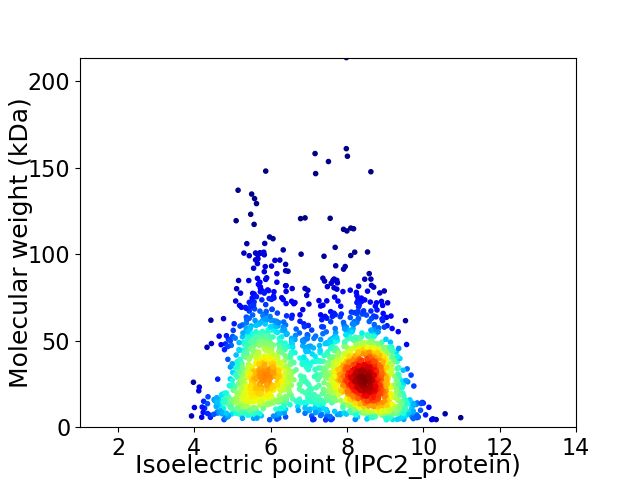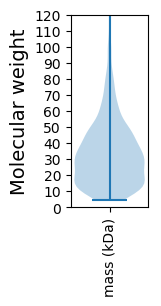
Thermodesulfovibrio yellowstonii (strain ATCC 51303 / DSM 11347 / YP87)
Taxonomy: cellular organisms; Bacteria; Nitrospirae; Thermodesulfovibrionia; Thermodesulfovibrionales; Thermodesulfovibrionaceae; Thermodesulfovibrio; Thermodesulfovibrio yellowstonii
Average proteome isoelectric point is 7.14
Get precalculated fractions of proteins

Virtual 2D-PAGE plot for 1982 proteins (isoelectric point calculated using IPC2_protein)
Get csv file with sequences according to given criteria:
* You can choose from 21 different methods for calculating isoelectric point
Summary statistics related to proteome-wise predictions



Protein with the lowest isoelectric point:
>tr|B5YK69|B5YK69_THEYD 30S ribosomal protein S6 OS=Thermodesulfovibrio yellowstonii (strain ATCC 51303 / DSM 11347 / YP87) OX=289376 GN=rpsF PE=3 SV=1
MM1 pKa = 7.16PTPVVDD7 pKa = 3.68YY8 pKa = 9.75DD9 pKa = 3.91LCVGCGSCAEE19 pKa = 4.13VCPEE23 pKa = 3.91VFEE26 pKa = 4.63MRR28 pKa = 11.84DD29 pKa = 3.25DD30 pKa = 3.98KK31 pKa = 11.66AWVVGPDD38 pKa = 3.03KK39 pKa = 11.2CSTCDD44 pKa = 3.4CQQAADD50 pKa = 4.6LCPSQAIRR58 pKa = 11.84LEE60 pKa = 4.09
MM1 pKa = 7.16PTPVVDD7 pKa = 3.68YY8 pKa = 9.75DD9 pKa = 3.91LCVGCGSCAEE19 pKa = 4.13VCPEE23 pKa = 3.91VFEE26 pKa = 4.63MRR28 pKa = 11.84DD29 pKa = 3.25DD30 pKa = 3.98KK31 pKa = 11.66AWVVGPDD38 pKa = 3.03KK39 pKa = 11.2CSTCDD44 pKa = 3.4CQQAADD50 pKa = 4.6LCPSQAIRR58 pKa = 11.84LEE60 pKa = 4.09
Molecular weight: 6.5 kDa
Isoelectric point according different methods:
Protein with the highest isoelectric point:
>tr|B5YHS0|B5YHS0_THEYD Probable membrane transporter protein OS=Thermodesulfovibrio yellowstonii (strain ATCC 51303 / DSM 11347 / YP87) OX=289376 GN=THEYE_A1866 PE=3 SV=1
MM1 pKa = 7.78PGFDD5 pKa = 2.86RR6 pKa = 11.84TGPFGQGPMTGRR18 pKa = 11.84GMGYY22 pKa = 9.75CGGASRR28 pKa = 11.84YY29 pKa = 7.65MNSASGRR36 pKa = 11.84RR37 pKa = 11.84FGFGRR42 pKa = 11.84GFRR45 pKa = 11.84CLGGFRR51 pKa = 11.84RR52 pKa = 11.84RR53 pKa = 11.84FRR55 pKa = 11.84WLWRR59 pKa = 11.84MPFFGGASSRR69 pKa = 11.84EE70 pKa = 3.75EE71 pKa = 4.06VEE73 pKa = 3.9WLKK76 pKa = 11.35EE77 pKa = 3.46EE78 pKa = 4.53AEE80 pKa = 3.95ILKK83 pKa = 10.5RR84 pKa = 11.84EE85 pKa = 4.13LEE87 pKa = 4.18AVQRR91 pKa = 11.84RR92 pKa = 11.84LSEE95 pKa = 3.95IEE97 pKa = 3.99KK98 pKa = 10.46EE99 pKa = 4.13KK100 pKa = 11.52AEE102 pKa = 4.06
MM1 pKa = 7.78PGFDD5 pKa = 2.86RR6 pKa = 11.84TGPFGQGPMTGRR18 pKa = 11.84GMGYY22 pKa = 9.75CGGASRR28 pKa = 11.84YY29 pKa = 7.65MNSASGRR36 pKa = 11.84RR37 pKa = 11.84FGFGRR42 pKa = 11.84GFRR45 pKa = 11.84CLGGFRR51 pKa = 11.84RR52 pKa = 11.84RR53 pKa = 11.84FRR55 pKa = 11.84WLWRR59 pKa = 11.84MPFFGGASSRR69 pKa = 11.84EE70 pKa = 3.75EE71 pKa = 4.06VEE73 pKa = 3.9WLKK76 pKa = 11.35EE77 pKa = 3.46EE78 pKa = 4.53AEE80 pKa = 3.95ILKK83 pKa = 10.5RR84 pKa = 11.84EE85 pKa = 4.13LEE87 pKa = 4.18AVQRR91 pKa = 11.84RR92 pKa = 11.84LSEE95 pKa = 3.95IEE97 pKa = 3.99KK98 pKa = 10.46EE99 pKa = 4.13KK100 pKa = 11.52AEE102 pKa = 4.06
Molecular weight: 11.75 kDa
Isoelectric point according different methods:
Peptides (in silico digests for buttom-up proteomics)
Below you can find in silico digests of the whole proteome with Trypsin, Chymotrypsin, Trypsin+LysC, LysN, ArgC proteases suitable for different mass spec machines.| Try ESI |
 |
|---|
| ChTry ESI |
 |
|---|
| ArgC ESI |
 |
|---|
| LysN ESI |
 |
|---|
| TryLysC ESI |
 |
|---|
| Try MALDI |
 |
|---|
| ChTry MALDI |
 |
|---|
| ArgC MALDI |
 |
|---|
| LysN MALDI |
 |
|---|
| TryLysC MALDI |
 |
|---|
| Try LTQ |
 |
|---|
| ChTry LTQ |
 |
|---|
| ArgC LTQ |
 |
|---|
| LysN LTQ |
 |
|---|
| TryLysC LTQ |
 |
|---|
| Try MSlow |
 |
|---|
| ChTry MSlow |
 |
|---|
| ArgC MSlow |
 |
|---|
| LysN MSlow |
 |
|---|
| TryLysC MSlow |
 |
|---|
| Try MShigh |
 |
|---|
| ChTry MShigh |
 |
|---|
| ArgC MShigh |
 |
|---|
| LysN MShigh |
 |
|---|
| TryLysC MShigh |
 |
|---|
General Statistics
Number of major isoforms |
Number of additional isoforms |
Number of all proteins |
Number of amino acids |
Min. Seq. Length |
Max. Seq. Length |
Avg. Seq. Length |
Avg. Mol. Weight |
|---|---|---|---|---|---|---|---|
0 |
608875 |
37 |
1843 |
307.2 |
34.81 |
Amino acid frequency
Ala |
Cys |
Asp |
Glu |
Phe |
Gly |
His |
Ile |
Lys |
Leu |
|---|---|---|---|---|---|---|---|---|---|
6.144 ± 0.056 | 1.109 ± 0.023 |
4.692 ± 0.034 | 7.9 ± 0.062 |
4.984 ± 0.049 | 6.356 ± 0.051 |
1.613 ± 0.022 | 9.946 ± 0.059 |
9.189 ± 0.055 | 9.679 ± 0.058 |
Met |
Asn |
Gln |
Pro |
Arg |
Ser |
Thr |
Val |
Trp |
Tyr |
|---|---|---|---|---|---|---|---|---|---|
2.229 ± 0.025 | 4.308 ± 0.04 |
3.82 ± 0.035 | 2.718 ± 0.031 |
4.15 ± 0.038 | 5.761 ± 0.04 |
4.654 ± 0.037 | 6.221 ± 0.047 |
0.87 ± 0.019 | 3.656 ± 0.035 |
Most of the basic statistics you can see at this page can be downloaded from this CSV file
Proteome-pI is available under Creative Commons Attribution-NoDerivs license, for more details see here
| Reference: Kozlowski LP. Proteome-pI 2.0: Proteome Isoelectric Point Database Update. Nucleic Acids Res. 2021, doi: 10.1093/nar/gkab944 | Contact: Lukasz P. Kozlowski |
